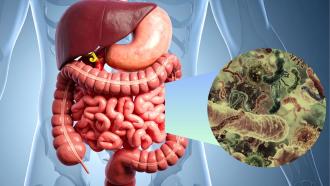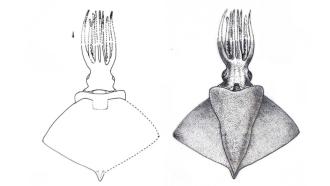
In 1960, American nutritionist and radio host popularised the phrase “You are what you eat" with a book of the same title. It refers to the idea that the food we consume not only provides energy but also has complex effects on our bodies, influencing everything from our mood to our lifespan. However, how exactly the nutrients from the food affect our health hasn’t been fully understood. To understand this, researchers have been studying how nutrients interact with our gut and brain, and how these two parts of the body communicate.
A recent study using the common roundworm Caenorhabditis elegans, also known as C. elegans, a transparent roundworm approximately 1 mm in length that inhabits temperate soil environments, has shed light on a connection between a common vitamin, nerve cells, and the gut. The study by researchers from BRIC-National Institute of Immunology (BRIC-NII), CSIR-Institute of Genomics and Integrative Biology (CSIR-IGIB), Academy of Scientific and Innovative Research (AcSIR), and University of Southern California, USA, reveals an internal highway from the brain to the gut that influences health and lifespan based on diet.
Did You Know? C. elegans was the first multicellular organism to have its whole genome sequenced, and in 2019 it was the first organism to have its connectome (neuronal "wiring diagram") completed. As of 2025, four Nobel prizes have been won for work done on C. elegans |
The vitamin in question is B12, a crucial nutrient that we can only get from our food or the tiny microbes living inside us. B12 is essential for a process called the methionine cycle, also known as Met-C, a type of factory inside our cells that helps build crucial molecules, including amino acids, DNA building blocks, and fats. B12 acts like a key tool in this factory, allowing an enzyme called methionine synthase (METR-1 in worms) to produce methionine, a crucial ingredient in the cycle. A lack of B12 slows down this factory. In humans, B12 deficiency and issues with the Met-C have been linked to brain problems and metabolic disorders like obesity and heart disease. But exactly how these links work across different parts of the body hasn't been fully clear.
C. elegans is a great model for studying this phenomenon because, like humans, it obtains B12 from the bacteria it consumes. For the new study, the researchers used an altered type of C. elegans that has a mutation in a gene called FLR-4. Typically, the FLR-4 protein acts like a brake, preventing specific pathways from getting too active. But in the flr-4 mutant worms, this brake is faulty. The team found that when these mutant worms consumed bacteria rich in B12, such as specific E. coli strains, they exhibited a couple of benefits: they were more resistant to stress and lived longer. This didn't happen on a low B-12 diet or when the bacteria were killed, showing that the living bacteria providing B-12 and other nutrients, such as methionine, were key.
Next, to identify which cells interacted with the B-12 in the worm, the team used genetic tricks to make the Met-C enzyme (METR-1) work only in specific tissues. This allowed them to pinpoint the cells that were being affected by the excess B-12 intake. They found that the Met-C factory needed to function correctly in the neurons for the worms to derive the stress resistance and longevity benefits from the high-B12 diet. If METR-1 only worked in the gut, there was no effect.
To understand how neurons in the brain communicate with the gut to become more stress-resistant and promote longevity, the researchers then examined a stress-response pathway in the gut known as the p38-MAPK pathway. They found that this pathway was activated in the gut of the flr-4 mutant worms on the high-B12 diet, and this activation was necessary for the health benefits. Therefore, the signal originated in the neurons (Met-C) and terminated in the gut (p38-MAPK).
The scientists then traced the signal. They found that the B12-driven Met-C in the neurons of the mutants led to increased production of serotonin, a neurotransmitter often associated with mood and behaviour. This serotonin was produced in specific neurons called ADF neurons. The serotonin then acted like a messenger, signalling other neurons. These receiving neurons then released a different messenger molecule, a neuropeptide called FLR-2. FLR-2 travelled to the gut and switched on the p38-MAPK stress pathway.
Essentially, when the worm eats B12-rich food, serotonin production is increased. This serotonin sends a signal to other brain cells to release a special messenger protein, called FLR-2. FLR-2 travels to the worm's gut and connects with a receiver there called FSHR-1. This connection activates a health switch called the p38-MAPK pathway, which in turn helps the worm cope with stress and live longer. The FLR-4 protein typically prevents this serotonin increase when B12 levels are high. However, the mutation ensures that the FLR-4 protein is ineffective in this setup.
The neuron-gut highway also influenced the worms' behaviour. The flr-4 mutant worms, which benefit from the high-B12 diet, actually preferred to eat the B12-rich bacteria! If any part of this signalling chain (Met-C in neurons, serotonin, FLR-2, FSHR-1, or p38-MAPK in the gut) was broken, the worms lost this preference. This suggests the worm's brain is using this B12-sensing pathway to guide its food choices towards the diet that's best for its long-term health.
However, while many parts of this pathway (such as Met-C, serotonin, and p38-MAPK) are found in humans, proteins like FLR-4, FLR-2, and FSHR-1 have weaker homologues in mammals. Further research is needed to determine if a similar core pathway exists in humans and to identify the key components involved.
The research, for the first time, explicitly identifies a detailed pathway linking a key nutrient (B12), neuronal metabolism (Met-C), a neurotransmitter (serotonin), a neuropeptide (FLR-2), and a gut stress pathway (p38-MAPK) to control lifespan and behaviour. The work provides a valuable model for understanding how our diet, gut microbes, and the communication between our brain and gut can influence our health and the ageing process.
This article was written with the help of generative AI and edited by an editor at Research Matters.






